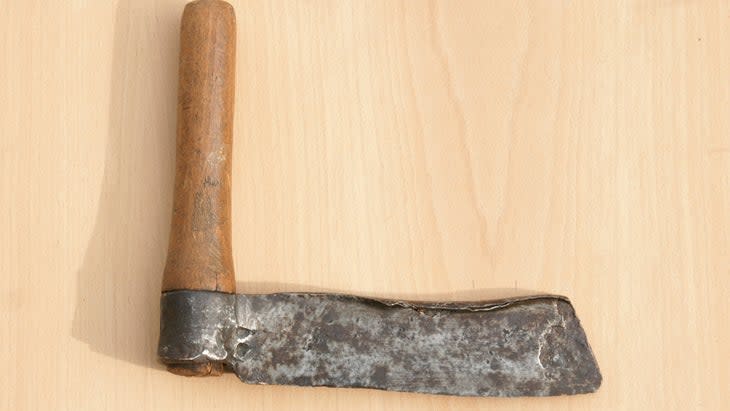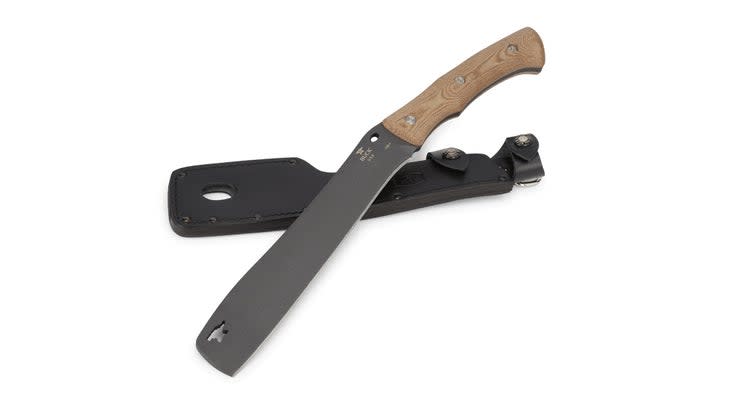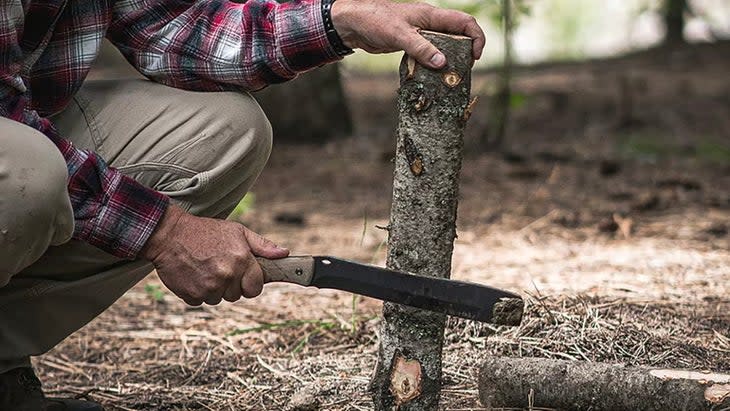Need to Split Wood in Camp? Consider Using a Froe.
This article originally appeared on Outside
Fire making is one camp chore I'm always trying to make easier. Whether it's simply collecting enough wood to enjoy a summer evening in the mountains, or desperately trying to keep the stove in my canvas wall tent hot enough to survive a sub-zero winter night, chopping and splitting logs into useable sizes involves a ton of time and effort. But for the last year or so, things have improved, thanks to the Buck Knives 108 Compadre Froe ($180).
What Is a Froe?
A froe is a traditional wood working tool that's shaped like an “L”. Used to precisely split logs apart along the grain, it features a heavy, wedge-shaped blade attached to a handle at a 90-degree angle. You use one by placing the blade atop a log in parallel with its grain, along the exact line you want to split apart, then whack the back of the blade with another log or a mallet. The long 90-degree handle then makes it easy to counter the rotational force applied by those whacks, keeping the blade perpendicular to the log as you separate it.

That's the same way you use a big survival-style knife to baton logs in camp. Only, as anyone who's used a knife to do this knows, it's more a tool that can get the job done, rather than one purpose designed to split wood. Why? Knife blades need to be able to slice, too. And combined with a need for portability, that often creates profiles that are too thin to make good wedges. To perform other tasks like meal prep or detailed wood work, knives also prioritize a balance point close to where the handle and blade meet, reducing their ability to chop. Valuable blade real estate is also lost to pointy ends, limiting their ability to span the full width of larger logs.
Why the 108 Compadre Froe Makes Splitting Wood Easy
That said, knives are easier to pack into the backcountry than some big L-shaped doohickey. And that's the problem Buck set out to fix when it designed the 108 Compadre Froe. It takes the blade from the traditional tool, and adds a handle similar (if ingeniously a little different) to a large survival knife. The result is a dedicated wood processing tool that's easy to carry, and incredibly useful.
Let’s start with that blade. It's a full-tang design--the material forms the length of the tool, with Micarta handle slabs bolted to it--made from spring steel. Lee Althen, a Senior Industrial Designer at Buck, tells me the flexibility inherent in that material, "has some shock absorption properties to make it less fatiguing on big jobs."

It's also .230-inches thick, and features a mid-grind that runs about halfway up the blade's width, to form a wedge that's much broader than that of most knives. The blade also swells toward the end to shift the balance point forwards, something Althen says, "makes for a great chopping swing."
The blade is also angled downwards from the handle, forming what Althen describes as, "a slight recurve shape," which, "helps keep the froe in the material [you’re splitting]."
The handle slabs bolted to the steel are made from Micarta, which is virtually indestructible, and provides comfortable traction for your hand even when it's wet. You'll notice that handle is very long, taking up seven and 1/4 inches of the tool's entire 16 3/4-inch total length, and that a swell separates that handle into two parts. Grip it forwards for fine control during small tasks, or rearwards to maximize leverage while chopping or batoning. You get a lot more power over this froe's blade than you do with the shorter handle on a traditional knife.
A hole in the blade just ahead of the handle also allows you to attach a lanyard, which you can then wrap around your hand to prevent it from sliding forward onto the blade.

Bottom Line: Opt for a Froe Instead of a Hatchet
I asked Althen why he'd choose this froe over a hatchet for wood-processing duties. "A froe is more versatile, and easier to use," he explains. "The weight balance is much closer to the handle, which means less strength is needed to use it (assuming the same weight between the froe and hatchet). The extra length makes it much easier to baton. And, you ultimately still have a knife edge that can be used for cutting or biting into wood enough to get started. From a safety standpoint, it's way harder to miss on a swing with the froe."
The only real downside here is weight. Just like a hatchet, you aren't going to want to carry the 23.2-ounce froe on your belt over long distances. But it's slim and portable enough to easily tag along in a truck, canoe, or ATV, and its nice leather sheath keeps it from cutting you or your things to pieces when it's not in use.
And that's where mine is right now, riding in my truck's Decked drawers alongside a first aid kit, a roll of trash bags, and a can of bug spray, ready to help make my next campfire.
For exclusive access to all of our fitness, gear, adventure, and travel stories, plus discounts on trips, events, and gear, sign up for Outside+ today.

